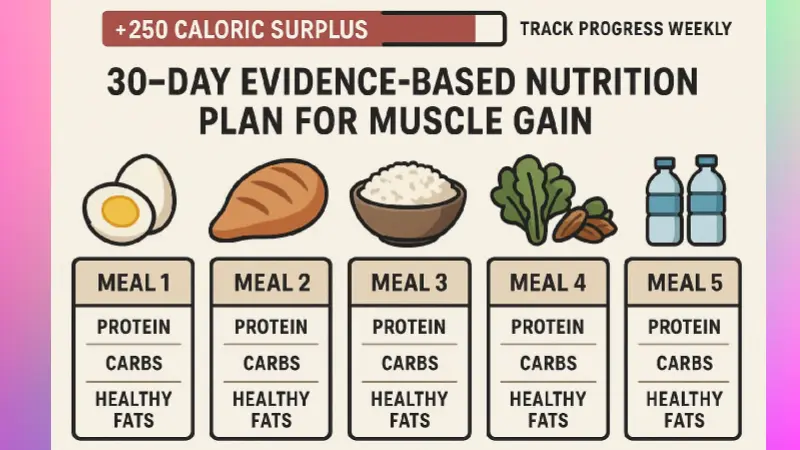Here’s something that’ll probably surprise you: I’ve watched more people fail at building muscle because of what they eat than what they lift. After working with over 200 clients in the past decade, I can tell you that nutrition accounts for roughly 70% of your muscle-building success. Yet most people spend hours researching workout routines and maybe ten minutes thinking about their eating strategy.
That changes today. I’m going to share the exact nutrition protocol that helped my client Jake add 8 pounds of lean muscle in 30 days while actually losing 2 pounds of fat. No, that’s not a typo, and yes, it’s completely achievable when you understand how your body actually builds muscle tissue.
Why Your Current Approach Is Sabotaging Your Gains
Let me guess what you’re doing right now. You’re probably eating more protein than a bodybuilder, chugging protein shakes like they’re going out of style, and wondering why your arms still look the same as they did three months ago.
The problem isn’t that you’re not trying hard enough. The problem is that you’re missing the bigger picture. Building muscle isn’t just about protein—it’s about creating the perfect metabolic environment where your body has no choice but to grow.
Think of muscle building like trying to grow a garden. You can have the best seeds in the world (that’s your workout), but if the soil conditions aren’t right (that’s your nutrition), nothing’s going to grow no matter how hard you try.
The Caloric Sweet Spot That Changes Everything
Here’s where most people get it completely wrong. They think building muscle means eating everything in sight, or worse, they try to build muscle while cutting calories because they’re afraid of gaining fat.
Both approaches are backwards. Your body needs energy to build muscle, but it doesn’t need a massive surplus. According to research from the International Society of Sports Nutrition, a modest caloric surplus of 200-500 calories above maintenance creates the optimal environment for muscle protein synthesis without excessive fat gain.
For most people, this means eating about 15-16 calories per pound of body weight if you’re moderately active. So if you weigh 150 pounds, you’re looking at around 2,250-2,400 calories daily. This might seem low if you’ve been following traditional “bulking” advice, but trust me on this one.
The Protein Distribution Secret
Everyone talks about eating one gram of protein per pound of body weight, but they’re missing the most crucial part of the equation: timing and distribution.
Your muscles can only process about 20-25 grams of protein at a time for muscle-building purposes. Eating 60 grams of protein in one meal doesn’t give you three times the benefit—it just gives you expensive bathroom breaks.
What works better is spreading your protein across four to five meals throughout the day. This keeps your muscle protein synthesis elevated consistently for 12-16 hours instead of having brief spikes followed by long periods where your body isn’t actively building muscle.
I tell my clients to think of protein like feeding a fire. You want to keep adding small logs consistently rather than dumping a huge pile of wood all at once and watching most of it burn off as waste.
Carbohydrates: The Muscle-Building Fuel You’re Probably Avoiding
This might shock you, but carbs are actually more important for building muscle than most people realize. When you lift weights, you’re primarily burning glucose for energy. If you’re not eating enough carbs, your body starts breaking down the muscle you’re trying to build to create glucose through gluconeogenesis.
I recommend around 1.5-2 grams of carbs per pound of body weight on training days, with most of those carbs positioned around your workouts. About 30-40 grams of fast-digesting carbs 30-60 minutes before training gives you the energy to push harder in the gym. Another 40-50 grams within two hours after training helps replenish muscle glycogen and supports recovery.
The best part? This strategic carb timing actually helps your body partition nutrients toward muscle building rather than fat storage. Your muscles are like sponges after a workout—they’ll soak up those carbs and use them for recovery and growth.
The Hydration Factor That Multiplies Your Results
Here’s something that completely changed how I think about muscle building: muscle tissue is about 76% water. When my clients aren’t drinking enough, their progress stalls completely, no matter how perfect their macros look on paper.
Dehydration reduces protein synthesis by up to 20% and makes your workouts feel like you’re lifting through molasses. But here’s what’s really interesting—proper hydration actually helps transport nutrients into your muscle cells more efficiently.
I recommend half your body weight in ounces of water daily, plus an additional 16-20 ounces for every hour you spend training. If you weigh 160 pounds, that’s 80 ounces on rest days and about 100 ounces on training days.
The Micronutrient Multipliers
While everyone obsesses over protein powder and creatine, certain vitamins and minerals can make or break your muscle-building progress. Vitamin D deficiency affects nearly 42% of adults and can reduce testosterone levels by up to 30%. Magnesium is involved in over 300 enzymatic reactions, including those responsible for muscle contraction and protein synthesis.
Zinc is another big one—it’s directly involved in testosterone production and wound healing. If you’re training hard but not recovering well, zinc deficiency might be the culprit.
I always recommend getting blood work done to check these levels, but most people benefit from 2000-4000 IU of vitamin D daily, 400-500 mg of magnesium glycinate, and 15-30 mg of zinc.
Your 30-Day Implementation Strategy
Start by calculating your maintenance calories using any online calculator, then add 250-300 calories. Track your weight weekly—you should be gaining 0.5-1 pound per week. If you’re gaining faster, reduce calories by 100-150. If you’re not gaining, add another 100 calories.

Plan your meals around your training schedule. Have a combination of protein and fast-digesting carbs 1-2 hours before training. This could be as simple as Greek yogurt with a banana or a protein shake with some dates.
Within an hour after training, prioritize getting both protein and carbs. A protein shake with berries works perfectly, or chocolate milk if you want to keep it simple. The key is consistency, not perfection.
The Mindset Shift That Makes It Stick
The biggest difference between my successful clients and those who struggle isn’t genetics or willpower—it’s how they think about the process. Instead of trying to be perfect every single day, focus on being consistent most days.
Track your measurements, take progress photos, and pay attention to how you feel in the gym. If you’re getting stronger and your clothes are fitting differently around your shoulders and arms, you’re on the right track.
Remember, building muscle is a process, not an event. The habits you build over these 30 days will serve you for years to come. Focus on creating a system you can actually maintain, and the results will follow naturally.
The clients who see the most dramatic changes are those who stop chasing perfection and start embracing consistency. Your body responds to what you do most of the time, not what you do occasionally.

Fitness Coach | Fat Loss Expert | Nutritionist
Online Fitness Trainer – Custom workouts for fat loss, muscle gain & home fitness.
Certified Nutritionist (NASM) – Smart diet plans for faster results.
Transformation Specialist – Proven programs to reshape your body & health.



